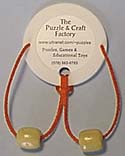by Cynthia
Sue Larson
August 28,
2000
I recently visited a friend, who loaned me a bead and rope
puzzle that had been sitting around her house unsolved for many years.
"Take it with you, and let me know if you
figure it out",
she said with a hopeful lilt to her voice as we said our
farewells.
I brought the deceptively simple puzzle with me inside my parents' house,
where it quickly became the center of attention. As one person after
another tried to solve the puzzle, I waited outdoors until the excitement
died down. About an hour later, I was delighted to enjoy my first private
inspection of it.
This puzzle was elegant in its simplicity. It consisted of two beads on
separate loops a rope that was firmly connected to a piece of wood at each
of its ends. There was a hole in the center piece of the puzzle from which
the ropes emerged into the separate loops for the two beads. The solution
to this puzzle was illustrated on the back of the wooden piece as a picture
of the two beads adjacent to one another on the same loop of rope.
I immediately sensed something about this puzzle... I could feel the
solution to it as clearly as if I was holding the solved puzzle in my
hands. Suddenly I knew that if I just held that image in my mind, I could
manipulate the beads and rope until the beads were side-by-side. I was not
closely studying every move I made, but was instead in a state of being at
one with the solution to the puzzle.
Within ten minutes, I'd solved the puzzle, and the two beads were resting
together on the same loop. My family was astonished to see the puzzle
solved so quickly, and wanted to know how I'd done it. I simply replied,
"I was at one with the
puzzle."
I got looks of disbelief and some annoyance at this remark,
but I didn't know how else to convey my feeling of being harmoniously
attuned to the solution. They wanted to see me solve the puzzle, but I
knew that any audience watching me so closely when I couldn't even watch
what I was doing myself would block me from being able to solve it.
I felt so aligned to the puzzle that solving it felt instinctive to me, as
if I'd worked this puzzle successfully hundreds of times and could use
motor memory. There was some truth to that, since my mother had brought
home several similar topographical puzzles when I was a teenager, and I'd
spent many enjoyable hours playing with them.
When my family's attention was once again diverted elsewhere and I had
another quiet moment to work unobserved, I moved the beads back apart from
one another again. This time, I paid a bit more attention to how I was
manipulating the ropes and beads, so that I would be able to help my family
solve the puzzle, too.
When my family saw the puzzle back in its original starting state, they
were astonished once again, and asked how I'd solved the puzzle. I
repeated, "I was at one with the puzzle", smiling as I said this, since I
saw how my enigmatic response made little sense to anyone.
As I showed my family the steps required to move one marble to the other
side, I realized:
it is possible to align oneself
with the
solution to any given problem,
and in doing so
find a seemingly
effortless approach.
The steps to doing this are simple:
(1) Observe an imagined future solution,
(2) With feelings of happiness and gratitude for finding the solution,
(3) Without staring too closely at what one is doing as one solves the
problem.
This reminds me of the wonderful adage:
"The one who says it cannot be done
should
never interrupt the one who is doing it"
lest we get so caught up in what we think we
know
that we can't see the world as it really is.

